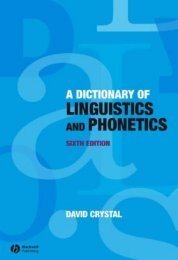url?sa=t&source=web&cd=3&ved=0CC0QFjAC&url=http://www.teachingenglish.org.uk/sites/teacheng/files/B369-Young-Learners-Activity-Book_v10
url?sa=t&source=web&cd=3&ved=0CC0QFjAC&url=http://www.teachingenglish.org.uk/sites/teacheng/files/B369-Young-Learners-Activity-Book_v10
url?sa=t&source=web&cd=3&ved=0CC0QFjAC&url=http://www.teachingenglish.org.uk/sites/teacheng/files/B369-Young-Learners-Activity-Book_v10
Create successful ePaper yourself
Turn your PDF publications into a flip-book with our unique Google optimized e-Paper software.
TeachingEnglish <strong>Young</strong> <strong>Learners</strong> <strong>Activity</strong> <strong>Book</strong><br />
Activities<br />
<strong>Activity</strong> 39: Throwing a ball<br />
Joanna Sanecka – Poland<br />
Age: All<br />
5–30 minutes Large classes? Yes Mixed level? Yes<br />
Materials: Soft objects that can be thrown, such as a soft ball or toy. You’ll need one<br />
for each group.<br />
Organisation: Whole class or large groups.<br />
Aim: To revise vocabulary.<br />
Description: In this activity, the children take it in turns to say a vocabulary item by throwing<br />
the ball to each other. The activity can be used to practise any set of vocabulary you like.<br />
There are a number of variations on this game and one alternative is given below.<br />
Preparation: You will need a ball (or the same number of balls as groups).<br />
Procedure<br />
1. Divide the class into groups of about ten. The game is played by each group at the same<br />
time. Ask the group to stand in a circle.<br />
2. Tell the students the area of vocabulary to be used in the game, for example, months of<br />
the year, colours, animals, numbers, clothes etc. and throw the ball to a child. The child<br />
who catches the ball says another word in the series and throws the ball to another child.<br />
This child also says a word in the series and throws the ball again.<br />
3. If a child gets a word wrong or can’t remember another item, either:<br />
a. The child is ‘out’ and the game continues until only one child is left and is the winner.<br />
or<br />
Notes<br />
b. The child changes the subject of the vocabulary group and a new round begins using<br />
the new vocabulary.<br />
If you don’t have room for the children to stand in circles, ask them to sit around tables.<br />
If you have desks in fixed rows, they can play by going down the row and back again.<br />
You can also use a soft toy rather than a ball.<br />
84<br />
© British Council 2012





